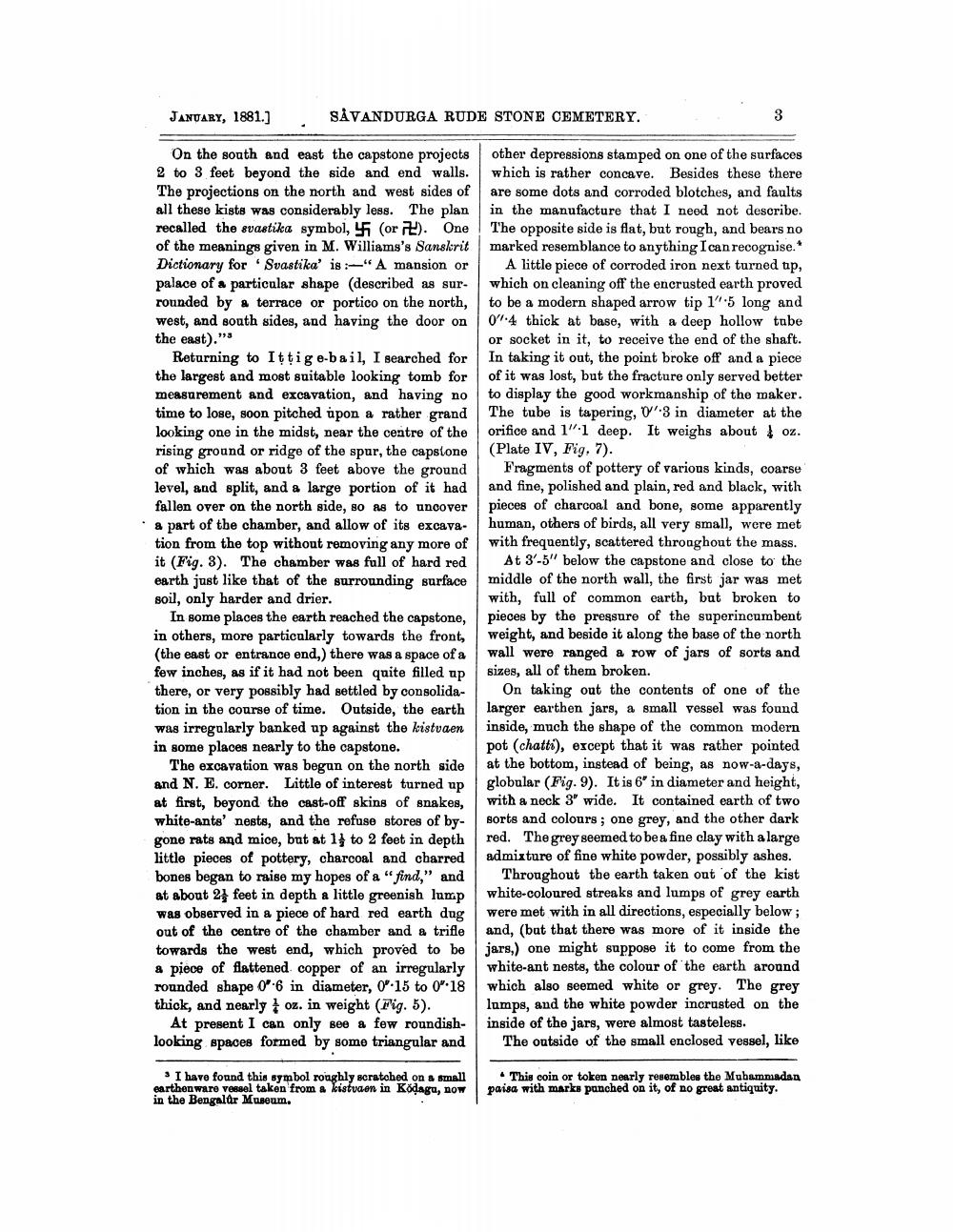Book Title: Indian Antiquary Vol 10 Author(s): Jas Burgess Publisher: Swati Publications View full book textPage 9
________________ JANUARY, 1881.] SÅVANDURGA RUDE STONE CEMETERY. 3 1001.) On the south and east the capstone projects 2 to 3 feet beyond the side and end walls. The projections on the north and west sides of all these kists was considerably less. The plan recalled the svastika symbol, 45 or 2). One of the meanings given in M. Williams's Sanskrit Dictionary for Svastika' is :-"A mansion or palace of a particular shape (described as surrounded by a terrace or portico on the north, west, and south sides, and having the door on the east)." Returning to Ittig e-bail, I searched for the largest and most suitable looking tomb for measurement and excavation, and having no time to lose, soon pitched upon a rather grand looking one in the midst, near the centre of the rising ground or ridge of the spur, the capstone of which was about 3 feet above the ground level, and split, and a large portion of it had fallen over on the north side, so as to uncover a part of the chamber, and allow of its excavation from the top without removing any more of it (Fig. 3). The chamber was full of hard red arth just like that of the surrounding surface soil, only harder and drier. In some places the earth reached the capstone, in others, more particularly towards the front, (the east or entrance end,) there was a space of a few inches, as if it had not been quite filled up there, or very possibly had settled by consolidation in the course of time. Outside, the earth was irregularly banked up against the kistvaen in some places nearly to the capstone. The excavation was begun on the north side and N. E. corner. Little of interest turned up at first, beyond the cast-off skins of snakes, white-ants' nests, and the refuse stores of bygone rats and mice, but at 14 to 2 feet in depth little pieces of pottery, charcoal and charred bones began to raise my hopes of a "find," and at about 2 feet in depth a little greenish lump was observed in a piece of hard red earth dug out of the centre of the chamber and a trifle towards the west end, which proved to be a piece of flattened copper of an irregularly rounded shape 0:6 in diameter, 0.15 to 0.18 thick, and nearly oz. in weight (Fig. 5). At present I can only see a few roundish- looking spaces formed by some triangular and other depressions stamped on one of the surfaces which is rather concave. Besides these there are some dots and corroded blotches, and faults in the manufacture that I need not describe. The opposite side is flat, but rough, and bears no marked resemblance to anything I can recognise." A little piece of corroded iron next turned tip, which on cleaning off the encrusted earth proved to be a modern shaped arrow tip 1':5 long and 04 thick at base, with a deep hollow tube or socket in it, to receive the end of the shaft. In taking it out, the point broke off and a piece of it was lost, but the fracture only served better to display the good workmanship of the maker. The tube is tapering, 3 in diameter at the orifice and 1".1 deep. It weighs about oz. (Plate IV, Fig. 7). Fragments of pottery of various kinds, coarse and fine, polished and plain, red and black, with pieces of charcoal and bone, some apparently human, others of birds, all very small, were met with frequently, scattered throughout the mass. At 3-5" below the capstone and close to the middle of the north wall, the first jar was met with, full of common earth, but broken to pieces by the pressure of the superincumbent weight, and beside it along the base of the north wall were ranged a row of jars of sorts and sizes, all of them broken. On taking out the contents of one of the larger earthen jars, a small vessel was found inside, much the shape of the common modern pot (chatti), except that it was rather pointed at the bottom, instead of being, as now-a-days, globular (Fig. 9). It is 6' in diameter and height, with a neck 3' wide. It contained earth of two sorts and colours; one grey, and the other dark red. The grey seemed to be a fine clay with a large admixture of fine white powder, possibly ashes. Throughout the earth taken out of the kist white-coloured streaks and lumps of grey earth were met with in all directions, especially below; and, (bat that there was more of it inside the jars) one might suppose it to come from the white-ant nests, the colour of the earth around which also seemed white or grey. The grey lamps, and the white powder incrusted on the inside of the jars, were almost tasteless. The outside of the small enclosed vessel, like I have found this symbol roughly scratohed on a small earthenware vessel taken from a kistvaon in Kodaga, now in the Bengalir Museum. This coin or token nearly resembles the Muhammadan paisa with marks punched on it, of no great antiquity.Page Navigation
1 ... 7 8 9 10 11 12 13 14 15 16 17 18 19 20 21 22 23 24 25 26 27 28 29 30 31 32 33 34 35 36 37 38 39 40 41 42 43 44 45 46 47 48 49 50 51 52 53 54 55 56 57 58 59 60 61 62 63 64 65 66 67 68 69 70 71 72 73 74 75 76 77 78 79 80 81 82 83 84 85 86 87 88 89 90 91 92 ... 440
